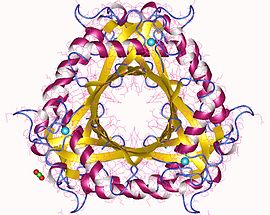| 6-carboxytetrahydropterin synthase | |||||||||
|---|---|---|---|---|---|---|---|---|---|
 6-Carboxy-5,6,7,8-tetrahydropterin synthase hexamer, E.Coli | |||||||||
| Identifiers | |||||||||
| EC no. | 4.1.2.50 | ||||||||
| Databases | |||||||||
| IntEnz | IntEnz view | ||||||||
| BRENDA | BRENDA entry | ||||||||
| ExPASy | NiceZyme view | ||||||||
| KEGG | KEGG entry | ||||||||
| MetaCyc | metabolic pathway | ||||||||
| PRIAM | profile | ||||||||
| PDB structures | RCSB PDB PDBe PDBsum | ||||||||
| |||||||||
6-carboxytetrahydropterin synthase (EC 4.1.2.50, CPH4 synthase, queD (gene), ToyB , ykvK (gene)) is an enzyme with systematic name 7,8-dihydroneopterin 3'-triphosphate acetaldehyde-lyase (6-carboxy-5,6,7,8-tetrahydropterin and triphosphate-forming).[1][2] This enzyme catalyses the following reversible chemical reaction.
- 7,8-dihydroneopterin 3′-triphosphate + H2O ⇌ 6-carboxy-5,6,7,8-tetrahydropterin + acetaldehyde + triphosphate
This enzyme binds Zn2+. It is isolated from the bacteria Bacillus subtilis and Escherichia coli. The stimulation is part of the biosynthesis pathway of queuosine. The enzyme from Escherichia coli can also convert 6-pyruvoyl-5,6,7,8-tetrahydropterin and sepiapterin to 6-carboxy-5,6,7,8-tetrahydropterin.[2]
References[edit]
- ^ Cicmil N, Shi L (February 2008). "Crystallization and preliminary X-ray characterization of queD from Bacillus subtilis, an enzyme involved in queuosine biosynthesis". Acta Crystallographica Section F. 64 (2): 119–22. doi:10.1107/s1744309108000924. PMC 2374184. PMID 18259064.
- ^ a b McCarty RM, Somogyi A, Bandarian V (March 2009). "Escherichia coli QueD is a 6-carboxy-5,6,7,8-tetrahydropterin synthase". Biochemistry. 48 (11): 2301–3. doi:10.1021/bi9001437. PMC 3227869. PMID 19231875.
External links[edit]
 Media related to 6-carboxytetrahydropterin synthase at Wikimedia Commons
Media related to 6-carboxytetrahydropterin synthase at Wikimedia Commons- 6-carboxytetrahydropterin+synthase at the U.S. National Library of Medicine Medical Subject Headings (MeSH)
Well, that’s interesting to know that Psilotum nudum are known as whisk ferns. Psilotum nudum is the commoner species of the two. While the P. flaccidum is a rare species and is found in the tropical islands. Both the species are usually epiphytic in habit and grow upon tree ferns. These species may also be terrestrial and grow in humus or in the crevices of the rocks.
View the detailed Guide of Psilotum nudum: Detailed Study Of Psilotum Nudum (Whisk Fern), Classification, Anatomy, Reproduction